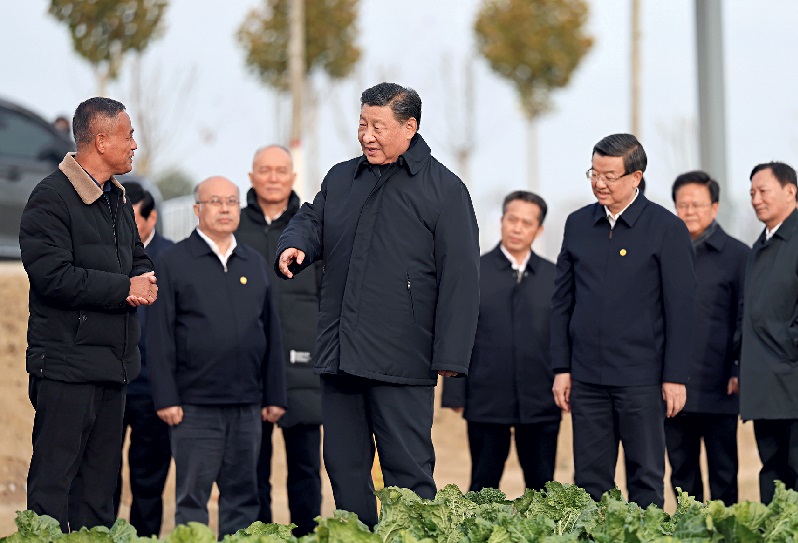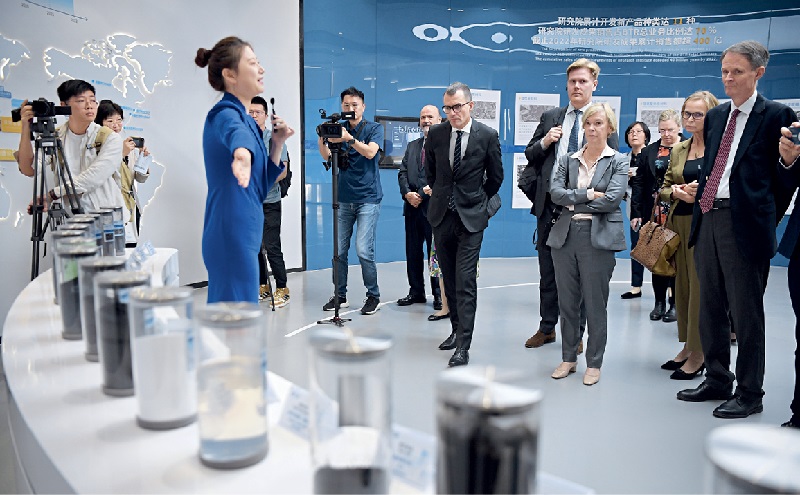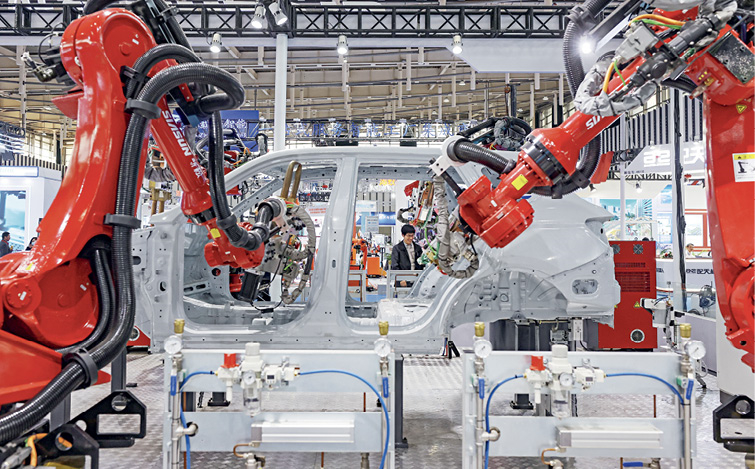
Chinese President Xi Jinping visits a farm in Wanquanzhuang Village in Zhuozhou, north China's Hebei Province on November 10, 2023 during his inspection tour of the areas affected by floods last summer in Beijing and Hebei Province.
Ringing in 2024, the New Year message that Chinese President Xi Jinping delivered on the evening of December, 31, 2023 in Beijing recalled the past year’s most heartening moments and highlighted the direction in which the country is sailing. Noting that 2024 marks the 75th anniversary of the founding of the People’s Republic of China, President Xi called for efforts to “steadfastly advance Chinese modernization, fully and faithfully apply the new development philosophy on all fronts, speed up building the new development paradigm, promote high-quality development, and both pursue development and safeguard security.”
For the Chinese president, the people remain his biggest concern, as he said in his message, the government’s ultimate goal is to deliver a better life for the people. President Xi also committed to ensuring China’s close work with the international community for the common good of humanity, thus incarnating the traditional Chinese cultural ethos whereby “all under heaven are of one family.”
Innovation Spearheads China’s High-Quality Development
President Xi described the advance of China’s high-quality development and the progress that China’s technical innovation has achieved over the past year as “solid steps” and “robust steps.” “Our modernized industrial system has been further upgraded. A number of advanced, smart, and green industries are rapidly emerging as new pillars of the economy,” Xi said.
Throughout 2023, in light of the primary task of advancing the country’s high-quality development, President Xi’s inspection tours spanned the country – from the burgeoning Yangtze River Delta in the east to Xinjiang’s vast expanses in the west, and from dynamic Guangdong Province in the south to the northeastern stretches of Heilongjiang. The vital role of scientific and technological innovation in the country’s development has thus been consistently emphasized. Xi noted that innovation is at the heart of the country’s modernization drive.
In accordance with its innovation-driven development strategy, China aims to join the ranks of the world’s most innovative countries by 2035. As one of the country’s most vibrant innovation hubs, the Yangtze River Delta saw the output value of its hi-tech manufacturing sector account for 31.1 percent of the national total in the first three quarters of 2023. Xi encouraged young R&D professionals to pursue a lifelong commitment to cutting-edge technologies, and advocated a pragmatic and solid path of innovation geared to improving self-reliance and building strength in science and technology. China’s total spending on R&D in 2022 stood at RMB 3.09 trillion, so tripling that of RMB 1 trillion in 2012. The country, moreover, possesses the world’s largest group of R&D personnel.
Xi mentioned in his New Year message such technological breakthroughs as the C919 large passenger airliner, the Chinese-built large cruise ship, the Shenzhou spaceships, and the deep-sea manned submersible Fendouzhe, as well as trendy brands that are both designed and made in China.
China rose to the 11th on the Global Innovation Index 2022 published by the World Intellectual Property Organization, so confirming the country’s consistent upward trend for 10 consecutive years.
Meanwhile, spurred by the belief that embracing green development is an inevitable path, the country’s high-quality development has laid great store by green and low-carbon practices. During his inspections of major coal production areas in Shaanxi and Inner Mongolia, President Xi stressed the importance of restructuring the energy sector and upgrading the energy industry. He advocated a proactive but cautious approach toward achieving carbon peak and carbon neutrality goals.
It was in 2023 that China’s renewable energy capacity – encompassing wind power, solar power, hydropower, and biomass energy – outstripped for the first time that of thermal power, accounting for more than half of the country’s installed power generation capacity. Today, renewable energy constitutes about one-third of the country’s total power consumption.
China has released an action plan, and selected 100 carbon-peak pilot cities and industrial parks, the first batch of 35 having been unveiled last November. Their aim is to meet the dual carbon goals of peaking carbon emissions by 2030 and achieving carbon neutrality by 2060. A 2023 report on China’s measures to address climate change shows that in 2022 China’s carbon emissions intensity decreased more than 51 percent from its 2005 level.
Meanwhile, China’s low-carbon development drive has fostered a booming new energy vehicle (NEV) industry. The country is indeed a pacemaker in the sector, as both its production and sales of NEVs top world rankings.
Having once said “‘The next China’ is China!” in a post on social media at the beginning of 2023, chairman of McKinsey & Company in Greater China Joe Ngai recently said, “After one year, I'm even more convinced that ‘the next China’ is still China.” In a Xinhua interview, Ngai described China’s market as “innovative and energetic on a large scale,” also noting that China leads the world in many fields of innovation, including digital technology, artificial intelligence, electric vehicles, and renewable energy.

Foreign diplomats visit the new material research and innovation exhibition hall of BTR New Material Group Co., Ltd. in Shenzhen, to get first-hand knowledge about China’s development, on November 28, 2023.
Delivering a Better Life for the People
President Xi’s New Year message also evoked vibrant and bustling scenarios of people pursuing a colorful and better life. They included scenic resorts thronged by holidaymakers, the new vogue of “village super league” football matches and “village spring festival galas,” and the growing numbers of people embracing low-carbon lifestyles.
In 2023, China’s endeavors to improve national fitness saw tangible progress. Sport is fast becoming an essential part of people’s daily lives, so underpinning the country’s efforts to be a sporting powerhouse. Originating in Rongjiang County, southwest China’s Guizhou Province, China’s Village Super League, which netizens have dubbed “Cun Chao,” enthralls millions, both on-site and online, effectively creating a national mass sports sensation. The village league has even established cooperation with the English Premier League, evident in a training program for local coaches.
Throughout 2023, outdoor sports became one of the most popular topics among young Chinese. A report on China’s outdoor sports, published last October, shows that individuals born in the 1990s have become the largest outdoor sports group, accounting for 36.1 percent, closely followed by those born in the 1980s with a 32.5 percent share. According to Xinhua, the report also revealed a 79 percent annual increase in outdoor sports-related orders in the first half of 2023, and a notable 221 percent surge over the same period of 2019.
China’s booming cultural and tourist industry in 2023 also mirrored how much richer people’s lives have become. National Bureau of Statistics data show that in the first three quarters of the year the total revenue of China’s cultural enterprises rose to RMB 9.16 trillion – a 7.7 percent year-on-year increase. The China Tourism Academy indeed predicted that China’s total tourism income in 2023 would bounce back to RMB 5.2 trillion – 91 percent of the 2019 figure.
Xi’s message depicted a better life for the people: “Our children should be well taken care of and receive good education. Our young people should have the opportunities to pursue their careers and succeed. And our elderly people should have adequate access to medical services and elderly care.”
As regards education, the country is advancing development of both academic and professional degrees. According to the Ministry of Education (MOE), by the end of the 14th Five-Year Plan period (2021-2025), China’s enrolment of professional master’s degree students is expected to rise to around two-thirds of all master’s students. The enrolment of professional doctoral degree students, moreover, will also increase significantly. The aim is to help students hone their skills to deal with practical problems in different fields. Professional degree programs are expected to bolster the growth of industries and regional development. Today China has 3.65 million on-campus postgraduate students, ranking second in the world. As of 2022, around 56.4 percent of China’s postgraduates held professional degrees, compared with 32.29 percent in 2012.
Employment is the essential guarantee for people’s pursuit of a better life. China’s government has hence prioritized job creation in its policy making. Since 2012, the number of newly created urban jobs each year has topped 11 million, those in the first 10 months of 2023 having reached 11.09 million. To ensure people’s well-being, China has also extended its social security system to the entire population.
To better serve the elderly population, the National Administration of Traditional Chinese Medicine issued a circular last December, stating that traditional Chinese medicine (TCM) hospitals across the country are required to establish geriatric departments, according to the size of the elderly population in the locality and their demand for TCM services.
The people’s housing needs also remain a priority on the government’s agenda. China will continue its targeted, differentiated policies geared to meeting more efficiently the people’s housing needs, and stabilizing the property market, according to Ni Hong, minister of housing and urban-rural development.
The construction of affordable housing and public infrastructure for both normal and emergency use, as well as the renovation of shanty towns in cities, will be promoted, the minister said. The country will also explore ways to address the housing need of new urban residents, young people, and migrant workers.
Data showed that, during the first 11 months of 2023, China renovated 53,000 old residential communities, to which some 32,000 elevators, 746,000 new parking spaces, and 14,000 elderly and child care facilities were added.

Robotic arms for automobile manufacturing are on display at the World Intelligent Manufacturing Conference 2023 in Nanjing, Jiangsu Province, on December 6, 2023.
For the Common Good of Humanity
While pursuing its own development, China has also embraced the world by fulfilling its responsibility as a major country, President Xi observed in his New Year message.
In fact, the year 2023 presented President Xi with a hectic diplomatic schedule, entailing four overseas trips, dozens of meetings with foreign leaders, chairing the first China-Central Asia Summit, and attending the Third Belt and Road Forum for International Cooperation, among others.
Xi fostered China’s cooperation with major countries in 2023 by virtue of paying a state visit to Russia last March, meeting U.S. President Joe Biden in San Francisco last November, and his frequent exchanges with European leaders. During his first trip abroad in 2023, Xi described his state visit to Russia as a journey of friendship, cooperation, and peace. During the global attention-riveting China-U.S. summit, Xi and Biden reached consensus on strengthening bilateral dialogue and cooperation in a range of fields. Meanwhile, China-EU exchanges also gathered pace, Xi having indicated that, amid the ever more turbulent international situation, the China-EU relationship carries strategic significance and implications for global peace, stability, and prosperity.
China’s relations with the developing world were also at the top of the president’s diplomatic agenda in 2023. During his state visit to South Africa last August, Xi co-chaired, with South African President Cyril Ramaphosa, the China-Africa Leaders’ Dialogue. Xi announced China’s three initiatives in regard to supporting Africa’s industrialization, agricultural modernization, and fostering of talent. Xi also attended the 15th BRICS Summit in Johannesburg, where six countries were invited to become new BRICS members. He stressed that such expansion reflects the BRICS countries’ resolve to unite and cooperate with other developing countries, to meet the expectations of the international community, and to serve the common interests of emerging markets and developing countries.
Neighborhood diplomacy was also featured in President Xi’s 2023 agenda. On May 19, Xi chaired the first China-Central Asia Summit in Xi’an, northwest China’s Shaanxi Province, a new milestone in China-Central Asia relations. Xi said at the summit that central Asian countries were welcome aboard the “express train” of China’s development. Last December, Xi paid a state visit to Vietnam, and was received with the country’s highest diplomatic protocol. Both sides agreed to build a China-Vietnam community with a shared future that carries strategic significance. It was a major historic decision made by the leaders of the two parties and countries.
The most important diplomatic event China hosted in 2023 was the Third Belt and Road Forum for International Cooperation, where Xi announced the eight major steps that China will take to support high-quality Belt and Road cooperation. Ten years on, the Belt and Road Initiative (BRI) has become the largest international cooperation platform, China having signed more than 200 BRI cooperation agreements with more than 150 countries and 30 international organizations across five continents. In responding to the expectations of all participating countries to achieve shared development and prosperity, and to the aspiration of all peoples for a better life, the BRI has become the world’s most popular international public good.
Aiming to build an open, inclusive, clean, and beautiful world of lasting peace, universal security, and shared prosperity, building a community with a shared future for mankind is the noble goal China has pursued in conducting major-country diplomacy with Chinese characteristics for the new era, according to the Central Conference on Work Relating to Foreign Affairs that convened last December.
No matter how the global landscape may evolve, peace and development remain the underlying trend, and only cooperation for mutual benefit can deliver, President Xi said in his message. He is hence committed to China’s working closely with the international community for the common good of humanity, building a community with a shared future for mankind, and making the world a better place for all.